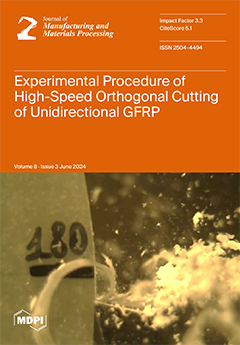Engineers continue to be concerned about electrical discharge-machined components’ high energy consumption, machining debris, and poor dimensional precision. The aim of this research is to propose a hybrid neuro-genetic approach to improve the machinability of the electrical discharge machining (EDM) of the Nimonic
[...] Read more.
Engineers continue to be concerned about electrical discharge-machined components’ high energy consumption, machining debris, and poor dimensional precision. The aim of this research is to propose a hybrid neuro-genetic approach to improve the machinability of the electrical discharge machining (EDM) of the Nimonic C263 superalloy. This approach focuses on reducing the energy consumption and negative environmental impacts. The material removal rate (
MRR), electrode wear ratio (
EWR), specific energy consumption (
SEC), surface roughness (Ra), machining debris (db), and circularity (C) are examined as a function of machining parameters such as the voltage (
V), pulse on time (
Ton), current (
I), duty factor (τ), and electrode type. By employing the
VIKOR method, all the responses are transformed into a distinctive
VIKOR index (VI). Neuro-genetic methods (a hybrid
VIKOR-based ANN-GA) can further enhance the best possible result from the
VIKOR index. During this step, the hybrid technique (
VIKOR-based ANN-GA) is used to estimate an overall improvement of 9.87% in the response, and an experiment is conducted to confirm this condition of optimal machining. This work is competent enough to provide aeroengineers with an energy-efficient, satisfying workplace by lowering the machining costs and increasing productivity.
Full article





